

Instructional Strategies / Home. Science and Literacy: Close Reading, CWA & more! - Boston Public Schools Science Department. Instructional Strategies (Idaho) We know that students learn best when they are truly engaged in what they are learning, when they have the opportunity to explore, debate, discuss, examine, defend, and experiment with the concepts and skills they are ready to learn.
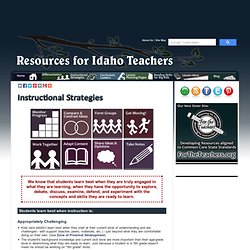
Students learn best when instruction is: Appropriately Challenging Kids (and adults!) Learn best when they start at their current level of understanding and are challenged - with support (teacher, peers, materials, etc.) - just beyond what they are comfortable doing on their own. Educator Resources - Talented and Gifted. Differentiated Instruction.
Rick Wormeli's Resources for Practical and Compelling Educational Change. Giving Students Meaningful Work:Even Geniuses Work Hard. Back to School: Differentiation for All Students. In every classroom we have students that are as different as condors are to capybaras.

A soaring condor's capacity has little to compare with the skill set of the water-loving capybara. Understanding their differences is the first step, but even if we create individual education plans that differentiate instruction for each student, teachers are forced to make choices that affect student learning when it comes to instructing them all at once. The issue is how do you provide instruction that meets the needs of each individual student?
The answer is you can't, but there are some other things that can. Tried-and-True Tactics I would like to introduce you to the idea of automatic differentiation. The only thing we have to do in automatic differentiation is to start the process and then let it go. Incorporating Differentiating Instruction Into Your Classroom New Teacher Resources. Video Archive - Differentiation Central. Event Registration DifferentiationCentral Reach Every Learner Every Day Through Differentiated Instruction Home | About Us | Events & Activities | Resources | Blog | Contact Us Video Archive DifferentiationCentral maintains an archive of video clips featuring experts in differentiated instruction.

MindShift. MindShift explores the future of learning in all its dimensions.
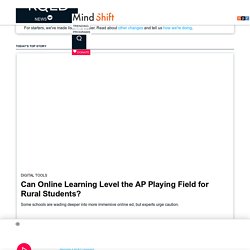
We examine how learning is being impacted by technology, discoveries about how the brain works, poverty and inequities, social and emotional practices, assessments, digital games, design thinking and music, among many other topics. We look at how learning is evolving in the classroom and beyond.We also revisit old ideas that have come full circle in the era of the over scheduled child, such as unschooling, tinkering, playing in the woods, mindfulness, inquiry-based learning and student motivation. Teachers are Learning Designers. Late in 2012, I wrote a blog for the Huffington Post that articulated what I really feel should be and is a role of great teachers.
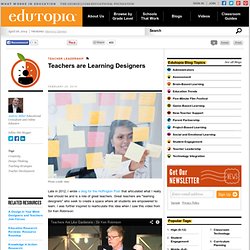
Great teachers are "learning designers" who seek to create a space where all students are empowered to learn. I was further inspired to rearticulate this idea when I saw this video from Sir Ken Robinson: What really struck me is that great teachers create the conditions for success, just as gardeners do. You can't make a flower grow, but you can design and improve the condition for that flow of naturally occurring events. It's the same for our students. Empower Yourself. Katie Novak Ed.D - Educational Consulting: Universal Design for Learning and the Common Core. How Teachers Learn:Fostering Reflection. Lana M.
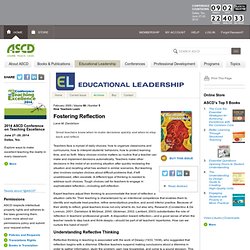
Danielson. Research Review: Multimodal Learning Through Media. Here are five rules for varying your teaching methods to help students learn more.
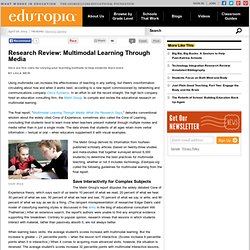
Using multimedia can increase the effectiveness of teaching in any setting, but there's misinformation circulating about how and when it works best, according to a new report commissioned by networking and communications company Cisco Systems. In an effort to set the record straight, the high tech company hired an education consulting firm, the Metiri Group, to compile and review the educational research on multimodal learning.
The final report, "Multimodal Learning Through Media: What the Research Says," debunks conventional wisdom about the widely cited Cone of Experience, sometimes also called the Cone of Learning, concluding that students tend to learn more when teachers present material through multiple modes and media rather than in just a single mode. Teaching With Multiple Modalities. Value Of Instructional Coaching For Teachers. Innovative Teaching Coaching Models. Strategy For Students To Use To Solve Problems. CER. Katherine L. McNeill - CER Guru. Designing Science Inquiry: Claim + Evidence + Reasoning = Explanation. In an interview with students, MIT's Kerry Emmanuel stated, "At the end of the day, it's just raw curiosity.

I think almost everybody that gets seriously into science is driven by curiosity. " Curiosity -- the desire to explain how the world works -- drives the questions we ask and the investigations we conduct. Let's say that we are planning a unit on matter. Teaching Students CER (Claim, Evidence, Reasoning) Two of the most fascinating and useful sessions that I attended had to do with the CER framwork, which stands for Claims, Evidence and Reasoning.
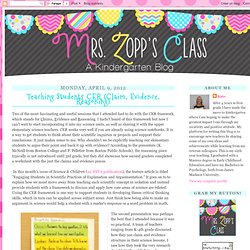
I hadn't heard of this framework but now I can't wait to start incorporating it into my science units, as well as sharing it with the upper elementary science teachers. CER works very well if you are already using science notebooks. It is a way to get students to think about their scientific inquiries or projects and support their conclusions. It just makes sense to me. What Makes a Question Essential? Second, look at these additional examples, organized by subject area, to spark your thinking and clarify the qualities of essential questions, or EQs.
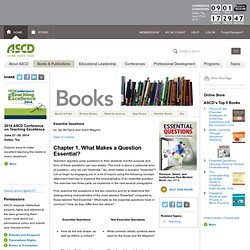
Essential Questions in History and Social Studies Whose "story" is this? How can we know what really happened in the past? How should governments balance the rights of individuals with the common good? Should _______ (e.g., immigration, media expression) be restricted or regulated? Blogs on Project-Based Learning. 5 Good Ideas for High Schools to Adapt from Elementary Schools. Always on the lookout for ways to help high schools run more smoothly and effectively, I keep noticing that many good ideas for improving high school programs and policies look a lot like the way elementary schools operate.
I wonder if some of these ideas from K-5 schools could be adapted for high schools. For example … 1. Focus on literacy. Literacy is the primary focus in most elementary classrooms. But what if high school kept reading and writing at the center of its curriculum, instead of trying to keep it in balance with other disciplines? 2. 10 Reasons To Try 20% Time In The Classroom. If you haven’t heard of 20% time in the classroom, the premise is simple: Give your students 20% of their class time to learn what they want. Yes, that’s it. Below is a list of the 10 reasons you should consider 20% time in your school, and you will not regret making that choice!
1. You will join a great community of learners When I first did the 20% project with my students I didn’t have a community of teachers or learners. 2. One of the major issues we face in schools today is covering a wide breadth of information, instead of allowing students to get a real depth of knowledge. Education Update:Planning for Processing Time Yields Deeper Learning:Guidelines for Creating Rubrics.
August 2013 | Volume 55 | Number 8 Planning for Processing Time Yields Deeper Learning Pages 2-2 Bryan Goodwin and Elizabeth Ross Hubbell's new book The 12 Touchstones of Good Teaching: A Checklist for Staying Focused Every Day includes a chapter on how to clarify performance expectations for students. Rubrics are an essential tool for delineating the criteria that distinguishes between novice and mastery-level work. Here are a few brief guidelines Goodwin and Hubbell recommend for creating rubrics, as well as a list of online tools to support your work: Identify the proficient level first.
In a four-tier rubric, we recommend that teachers identify level 3 of the rubric first. Build the rest of the rubric around proficiency. Focus on growth. Online Tools. Assessment For Learning. Bell Ringer Exercises. Because of pressure to teach bell-to-bell -- the pedagogical equivalent of force-feeding geese to make foie gras -- many classrooms now start with bell work, short exercises that students complete while the instructor attends to attendance and other administrative chores. Journal prompts and concept questions can focus students on nutritious academic content and initiate a positive tempo for the next 90 minutes of class.
With the help of graduate student David Fictum, I collected several creative, practical and entertaining exercises that can function as bell ringers or sponge activities. Classroom Warm-Up Routine: Math Class Warm-Up. Register Now and join a community of a million educators. Take 30 seconds to register (it's free!) And: Daily Assessment Of Students With Tiered Exit Cards. Stoplight Method - End-of-Class Assessment. Use Texting In The Classroom To Assess Student Learning. Infinitely Reusable Folders. Interactive Rubrics as Assessment for Learning. Last week, I was composing a rubric to go along with a writing assignment for my juniors. The assignment, though cleverly disguised as an end-of-unit essay for One Flew Over the Cuckoo's Nest, is actually a mock paper for the IB Language and Literature curriculum. Science Assessment ~ Topics. Ohio Performance Based Assessment Sample Items.
Assessment Literacy. Assessment literacy is more important than ever to inform professional learning and instructional practices. Rethinking Classroom Assessment with Purpose in Mind (Webcast) Webcast:April 27, 2006. Giving Students Meaningful Work:Seven Essentials for Project-Based Learning. Balancing Independent Work Time With Group Work. Structured Groups: Using Structured Groups In The Classroom Video. Register Now and join a community of a million educators. Providing Effective Feedback. Educational Approachs. Blended Learning. Four Essential Principles of Blended Learning. Personalized Learning. Deeper Learning: A Series Overview Deeper Learning.
Deeper Learning Through Linked Learning.
Sources & Resources. To Make Science Real, Kids Want More Fun And Fewer Facts. Hide captionHands-on science activities like making bubble mitts at the Mission Science Workshop teach students about things like surface tension. Understanding Science. Teaching resources. How science works: The flowchart. This flowchart represents the process of scientific inquiry, through which we build reliable knowledge of the natural world. You can use it to trace the development of different scientific ideas and/or the research efforts of individual scientists. Most ideas take a circuitous path through the process, shaped by unique people and events.
Move your mouse pointer over the flowchart to reveal an additional level of detail. Click on items in the flowchart to get further information in Understanding Science 101. The C21st Learner. High School Students Need to Think, Not Memorize. 25 Question Stems Framed Around Bloom's Taxonomy. 25 Question Stems Framed Around Bloom’s Taxonomy While critical thinking is a foundation rather than a brick, how you build that foundation depends on the learning process itself: exposing students to new thinking and promoting interaction with that thinking in a gradual release of responsibility approach.
Question stems can be a powerful part of that process no matter where the learner is. Ten Takeaway Tips for Teaching Critical Thinking.